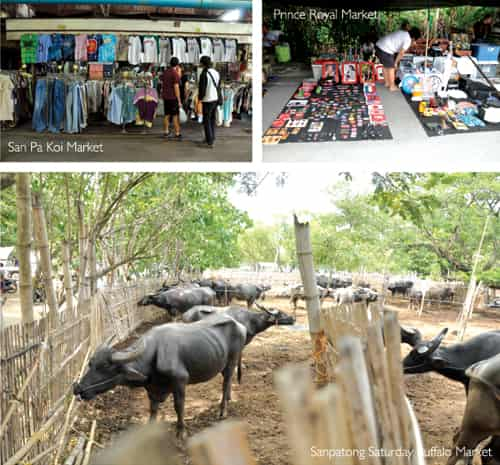

Beyond the more obvious options, a variety of unusual markets are scattered throughout the city. Whether you’re looking to pick up a bone-carved opium pipe, eat fried cockroaches, find a mystical Buddhist amulet or purchase your very own water buffalo, each place offers a melting pot of subcultures and rare wonders to discover. Here are just a few gems to check out!
Amulet Market (Kad Kham Tieng):

MCC (Multiple Cropping Centre) Market Fair:
Located down Chiang Rai 2 Road, which cuts between Nimman and CMU‘s clock tower, this bi-weekly produce market is an early bird’s dream, held on Wednesdays and Saturdays from 5 a.m. to noon. As part of the university’s Department of Agriculture (under the patronage of HM the King’s Royal Project), the market presents a cornucopia of organic produce direct from campus crops or brought in by farmers from surrounding areas. Here you can not only find the freshest food for low prices, but you can also meet the farmers that grow it! Best of all, the use of chemical pesticides is banned from all produce sold, making this spot a haven for the health conscious.

San Pa Koi Market:
This unassuming little souk, located opposite the Wat Gate area on Charoen Mueang Road (open 10 a.m. – 5 p.m. daily) may look like your everyday fresh market, selling fruits, vegetables, meat, fish, rice and other dry goods. But tucked in between the flurry of foodstuffs, in-the-know locals browse a small maze of thrift shop stalls selling inexpensive secondhand clothing. Paw through the racks to find rare gems, from a perfectly worn-in vintage band t-shirt to funky corduroy Levi bellbottoms to a one-of-a-kind pair of silver 70s platforms.
Sanpatong Saturday Buffalo Market (Tung Fha Bod):
Far off the trail for most tourists, this is a highly unusual and thoroughly Thai experience for a Saturday morning. A true farmers market that started 60 years ago as a weekly gathering of growers and traders, Tung Fha Bod has now become one of the largest weekend markets in Northern Thailand. Located in central Sanpatong on Hang Dong Road, about 30km south of Chiang Mai city, the market opens quite early (around 5 a.m.) and ends by noon, so it’s best to arrive by 7 to catch the best deals and witness the farmers in action. Like many other Thai markets, you’ll find typical food stalls, a variety of produce and bargain clothing (from straw hats to colourful vintage Converse shoes), but the main attraction is the bull and water buffalo pen. Yes, here is where you can fulfil your lifelong dream of buying your very own water buffalo! Locals also often come to purchase fighting cocks, and apparently it’s one of the best places in Thailand to buy used motorbikes (starting around 10,000 baht).
Thung Kwian Market:
Along Route 11 in the Hang Chat district, between Chiang Mai and Lampang, you’ll find several unusual “jungle markets” or “talad paa,” presenting a variety of items collected directly from the nearby jungle. Those with an experimental palate can revel in an abundance of daring (but perhaps not so delectable) cuisines – including fried cockroaches, tarantulas, frogs, bamboo rats, snakes, weasels, and soft-shell turtles (yes, they exist). For a real treat, check out the roasted quail-on-a-stick displayed out front!
Saturday Walking Street:
Similar to the popular Sunday Walking Street, but less touristy and less crowded, the Saturday Walking Street takes place on Wualai Road, just south of the Old City. The road is blocked off weekly from around 5 to 11 p.m., and packed full of vendors selling handicrafts, laquerware and clothing similar to those found on the Sunday Walking Street (in fact, many of the vendors are the same). The clientele is mostly young Thai families and college girls, meaning there’s a better chance to find bargains and a more chilled-out vibe overall. An area long-renowned for its silver, here you can also watch expert silversmiths meticulously hammering out beautiful designs on bowls, cups, bracelets, rings and wall murals.
Prince Royal Market:
This on-campus market is open to all and runs every Saturday and Sunday from late morning until afternoon, around 3 or 4 p.m. Accessible via Rattanakosin or Kaew Nawarat Road, it is one of the largest secondhand, retro-style markets in town, and items are sold directly from passionate collectors. You will find everything here: old TVs, spare car parts, gramophone records, used furniture, books, Buddha images, cameras, clothes, toys, posters and much more. After a day of diddle-daddling and picking up doodads that you thought you didn’t need, be sure to grab an iced coffee from the bright orange VW coffeemobile at the end of the street.

